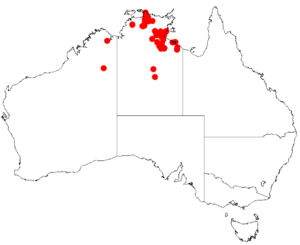Acacia conspersa facts for kids
Quick facts for kids Acacia conspersa |
|
|---|---|
| Scientific classification | |
| Genus: |
Acacia
|
| Species: |
conspersa
|
 |
|
| Occurrence data from AVH | |
Acacia conspersa is a type of shrub or small tree. It belongs to the Acacia family, also known as wattles. This plant grows naturally in northern Australia.
What Acacia conspersa Looks Like
This plant can be a shrub or a tree. It usually grows about 1.5 meters tall. Some can even reach up to 7.5 meters high. Its branches spread out or hang down a little.
The bark is rough and can be brown or grey. It might look stringy or have long cracks. Its small branches are round and covered in many soft hairs.
Like most Acacia plants, it does not have regular leaves. Instead, it has special flattened stems called phyllodes. These phyllodes are always green and feel tough. They are often covered in small scales.
The phyllodes are narrow and can be straight or slightly curved. They are usually 3.5 to 8.5 centimeters long. They are about 4 to 12 millimeters wide. Each phyllode has one clear main vein. It also has two smaller veins, one on each side.
Acacia conspersa blooms between April and October. It produces bright yellow flowers. These flowers grow on spikes that are 3 to 4.5 millimeters long.
After the flowers, seed pods grow. These pods are tough and have long stripes. They are also covered in small flakes. The pods are long and narrow, about 4 to 13 centimeters long. They are 3 to 5 millimeters wide. Inside, there are dark brown seeds. Each seed is about 4.6 to 5.7 millimeters long.
How Acacia conspersa Got Its Name
A botanist named Ferdinand von Mueller first officially described this plant. He did this in 1859. His description was part of a scientific paper. It was published in a journal called Journal of the Proceedings of the Linnean Society, Botany.
Acacia conspersa can sometimes be confused with another plant. That plant is called Acacia leptostachya.
The very first sample of this plant was collected by von Mueller himself. He found it in 1856 near the Gulf of Carpentaria. This first sample is called the "type specimen." It helps scientists know exactly what the plant looks like.
Where Acacia conspersa Grows
This plant is endemic to tropical parts of the Northern Territory. This means it only grows naturally in this area.
You can often find it along creeks or in small valleys. It also grows on sandstone hills. It likes to grow in groups or colonies. The soil it prefers is sandy or stony.
Acacia conspersa grows in different plant communities. These include shrublands and savannah grasslands. It can also be found in Eucalyptus woodlands or wet forests.

